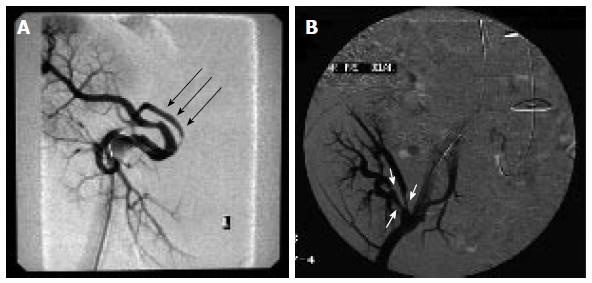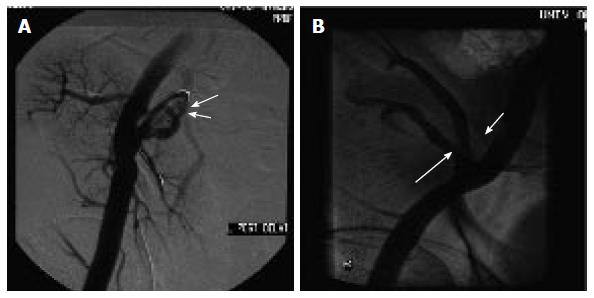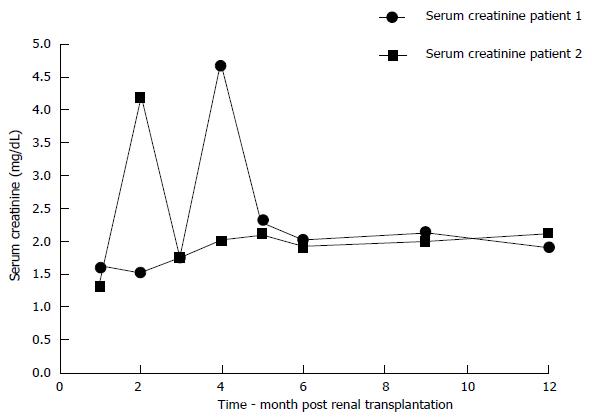Published online Jun 24, 2015. doi: 10.5500/wjt.v5.i2.68
Peer-review started: October 31, 2014
First decision: November 14, 2014
Revised: February 2, 2015
Accepted: March 18, 2015
Article in press: March 20, 2015
Published online: June 24, 2015
Processing time: 233 Days and 14.7 Hours
Transplant renal artery stenosis (TRAS) is a relatively rare complication after renal transplantation. The site of the surgical anastomosis is most commonly involved, but sites both proximal and distal to the anastomosis may occur, as well. Angioplasty is the gold standard for the treatment of the stenosis, especially for intrarenal lesions. We report two cases of intrarenal TRAS and successful management with angioplasty without stent placement. Both patients were male, 44 and 55 years old respectively, and they presented with elevated blood pressure or serum creatinine within three months after transplantation. Subsequently, they have undergone angioplasty balloon dilatation with normalization of blood pressure and serum creatinine returning to baseline level. Percutaneous transluminal balloon renal angioplasty is a safe and effective method for the treatment of the intrarenal TRAS.
Core tip: Transplant renal artery stenosis is a relatively rare complication after renal transplantation and usually affects the site of the surgical anastomosis. Intrarenal stenosis is rather uncommon, manifesting with uncontrolled hypertension and rise in serum creatinine. Angioplasty is the gold standard for the treatment of the stenosis, especially for intrarenal lesions.
- Citation: Koukoulaki M, Brountzos E, Loukopoulos I, Pomoni M, Antypa E, Vougas V, Drakopoulos S. Successful endovascular treatment of transplant intrarenal artery stenosis in renal transplant recipients: Two case reports. World J Transplant 2015; 5(2): 68-72
- URL: https://www.wjgnet.com/2220-3230/full/v5/i2/68.htm
- DOI: https://dx.doi.org/10.5500/wjt.v5.i2.68
Transplant renal artery stenosis (TRAS) is a rare complication after renal transplantation. Its incidence varies between 2.7%-23%[1]. Its clinical consequences are renal dysfunction which occurs with elevation in serum creatinine or refractory hypertension. The ultrasound is the first tool for the diagnosis of the stenosis but the angiography is method of choice for the confirmation of the diagnosis[2]. Angioplasty is the gold standard for the treatment of the disease and allows the placement of intraluminal stents to maintain patency of the stenosed segments[3,4]. It can be localized at the site of the anastomosis, proximal or distal to the anastomosis at the iliac artery. Rarely the site of the stenosis can be localized into the renal parenchyma. We present two patients who underwent renal transplantation from cadaveric donors and who developed renal artery stenosis at the intrarenal segment of the transplant artery during the early postoperative period.
A 44-year-old man received a first cadaveric renal allograft. He suffered end-stage renal disease due to chronic pyelonephritis. Demographic characteristics are shown in Table 1. Immunosuppression included induction therapy with basiliximab and triple regimen (cyclosporine, mycophenolate mofetil and corticosteroids). The patient had immediate recovery of graft function. The ultra-sound routinely performed on day 3 was normal. Four months after transplantation the patient presented with elevated blood pressure (180/100 mmHg) and elevated serum creatinine (4.2 mg/dL) and readmitted to the hospital. The ultrasound revealed a severe stenosis at the midportion of the renal transplant artery. Angiography confirmed 70% stenosis at the intrarenal portion of the branch which supplies the middle and lower portion of the kidney (Figure 1A), and angioplasty was performed using a 3.5 mm balloon (Figure 2A). One week after the transplantation the serum creatinine was at 2.3 mg/dL and the blood pressure was normal. Sequential values of serum creatinine are plotted in Figure 3. Since then the recipient has good renal graft function during follow-up for 14 mo.
| Case patient 1 | Case patient 2 | |
| Donor type | Cadaveric | Cadaveric |
| Donor age (yr) | 67 | 42 |
| Donor gender | Male | Male |
| Donor co-morbidities | Hypertension | None reported |
| Donor smoking habit | No | Yes |
| Recipient age (yr) | 44 | 55 |
| Recipient gender | Male | Male |
| Recipient primary renal disease | Chronic pyelonephritis | Membranous Glomerulopathy |
| Time on hemodialysis | 5 yr | 7 yr |
| Number of antihypertensive agents following repair of intrarenal transplant artery stenosis | One (amlodipine) | One (amlodipine) |
A 55-year-old man with end stage renal disease due to membranous glomerulopathy received a cadaveric kidney. Induction therapy was administered with basiliximab followed by triple immunosuppressive regimen (cyclosporine, mycophenolate mofetil and corticosteroids). Two months after transplantation during the routine follow-up, an elevated serum creatinine was discovered (4.7 mg/dL). An ultrasonography raised suspicion of severe stenosis at the intrarenal portion of the two main branches of the renal transplant artery. The finding was confirmed by angiography (Figure 1B) and subsequently the patient was submitted to angioplasty dilatation using a 5 f balloon (Figure 2B). Five days after the angioplasty the serum creatinine was 1.8 mg/dL. Sequential values of serum creatinine are plotted in Figure 3. During a one year follow-up the patient is well with satisfactory renal graft function.
The incidence of TRAS varies between 2.7% to 23%[1]. Risk factors for its development are poor anastomotic technique, traction injuries on the renal artery at the time of retrieval, intimal damage at the time of perfusion and atheroma at the site of the anastomosis. The role of acute rejection is controversial but chronic allograft nephropathy may play a role[5]. In our study both of the recipients were not older than 55 years old, there was not acute rejection episode, the stenosis was located distal to the anastomosis and into the renal parenchyma, and it occurred early after the transplantation. So it is difficult to consider one of the above mentioned factors as responsible for the arterial stenosis.
The clinical presentations of stenotic lesions are variable. Most of them present with progressive accelerated hypertension with or without biochemical evidence of renal allograft dysfunction, or they discovered incidentally during the routine follow-up examination[3].
The Doppler and color flow Duplex ultrasound are highly sensitive for the diagnosis of TRAS[6,7]. Of course both of them are operator dependent, but are also non invasive and can give some extra information of anatomical details. In our study the ultrasound was able to demonstrate not only the stenosis but also to pinpoint the exact segment and the degree of the stenosis.
Angiography is still the method of choice for the confirmation of the diagnosis of a stenosis, even in cases that non invasive methods have demonstrated its existence. It allows the complete visualization of the graft vasculature, and also the proximal ipsilateral arterial segments. There are potential complications, such as thromboembolism, haematoma formation, pseudoaneurysm and AV fistula formation. None of these complications occurred in our patients.
Percutaneous transluminal balloon renal angioplasty is considered to be the gold standard for the treatment of TRAS. Moreover there is the possibility of intraluminal stent placement for the preservation of the patency of the vessel lumen mainly in cases of refractory or recurrent stenosis. The success of the procedure is manifested by the improvement of the blood pressure control, the discontinuation of the anti-hypertensive medications and the normalization of the serum creatinine levels. The success rate immediately after the procedure has been reported to be greater than 80%[5,8]. Long term follow-up at one year is reported to be 63%-82%, with the rate of recurrence stenosis after PTA range from 10% to 36%[8-10].
In both of our cases, the PTA procedure was successful in controlling the blood pressure and normalization of the serum creatinine levels without stent placement, and this result is maintaining more than one year follow-up. No complications such as haematoma, aneurysm thrombosis were observed, although in the first case there was a longitudinal stenosis, and in the second there were two separate stenosis in the renal parenchyma.
The other option for the confrontation of TRAS would be the surgical procedure. The short term success results after surgery is reported to be 81%-95% and the long term patency is maintained in 63%-92% of cases[1]. It must be emphasized however that despite these good success rates surgery is difficult to repair surgically in cases that the location of the stenosis is into the renal parenchyma. In such cases the PTA with or without stent placement is probably the only procedure which could resolve the problem.
Renal graft artery stenosis is a relatively rare complication after renal transplantation, the localization of the stenosis into the renal parenchyma is rather uncommon. The PTRA offers the possibility for a safe treatment with good long term results in such cases were it would be difficult or even impossible for a surgical procedure to be undertaken.
Two renal transplant recipients presenting shortly after renal transplantation with uncontrolled blood pressure and elevated serum creatinine.
Renal transplant artery stenosis.
Renal allograft rejection, CNI toxicity, interstitial nephritis, recurrence of primary renal disease.
Case 1: Serum Creatinine: 4.2 mg/dL; Case 2: Serum Creatinine 4.7 mg/dL.
Ultrasound revealed severe stenosis after the orifice of the renal transplant artery.
Angiography showed 70% stenosis at the intrarenal portion of the branch of renal transplant artery.
Angioplasty with balloon dilatation.
Intrarenal transplant artery stenosis in rather rare in renal transplant recipients especially when diagnosed relatively recently post renal transplantation.
Angioplasty is the method of choice in repairing renal transplant artery stenosis especially for intrarenal lesions.
Uncontrolled blood pressure in renal transplant recipients should prompt for laboratory exams and further imaging studies.
Authors refer two cases of post-transplant intrarenal artery stenosis leading to renal insufficiency and once elevated blood pressure as well. The applied percutaneous transluminal angioplasty in this condition looks to be safe and long-lasting solution even without stent implantation, so the described cases are worth to be published.
P- Reviewer: Fulop T, Nemcsik J S- Editor: Song XX L- Editor: A E- Editor: Wu HL
| 1. | Fervenza FC, Lafayette RA, Alfrey EJ, Petersen J. Renal artery stenosis in kidney transplants. Am J Kidney Dis. 1998;31:142-148. [RCA] [PubMed] [DOI] [Full Text] [Cited by in Crossref: 178] [Cited by in RCA: 161] [Article Influence: 6.0] [Reference Citation Analysis (0)] |
| 2. | O’neill WC, Baumgarten DA. Ultrasonography in renal transplantation. Am J Kidney Dis. 2002;39:663-678. [RCA] [PubMed] [DOI] [Full Text] [Cited by in Crossref: 49] [Cited by in RCA: 43] [Article Influence: 1.9] [Reference Citation Analysis (0)] |
| 3. | Akbar SA, Jafri SZ, Amendola MA, Madrazo BL, Salem R, Bis KG. Complications of renal transplantation. Radiographics. 2005;25:1335-1356. [RCA] [PubMed] [DOI] [Full Text] [Cited by in Crossref: 153] [Cited by in RCA: 126] [Article Influence: 6.6] [Reference Citation Analysis (0)] |
| 4. | Beecroft JR, Rajan DK, Clark TW, Robinette M, Stavropoulos SW. Transplant renal artery stenosis: outcome after percutaneous intervention. J Vasc Interv Radiol. 2004;15:1407-1413. [RCA] [PubMed] [DOI] [Full Text] [Cited by in Crossref: 81] [Cited by in RCA: 85] [Article Influence: 4.3] [Reference Citation Analysis (0)] |
| 5. | Wong W, Fynn SP, Higgins RM, Walters H, Evans S, Deane C, Goss D, Bewick M, Snowden SA, Scoble JE. Transplant renal artery stenosis in 77 patients--does it have an immunological cause? Transplantation. 1996;61:215-219. [RCA] [PubMed] [DOI] [Full Text] [Cited by in Crossref: 112] [Cited by in RCA: 102] [Article Influence: 3.5] [Reference Citation Analysis (0)] |
| 6. | Goel MC, LaPerna L, Whitelaw S, Modlin CS, Flechner SM, Goldfarb DA. Current management of transplant renal artery stenosis: clinical utility of duplex Doppler ultrasonography. Urology. 2005;66:59-64. [RCA] [PubMed] [DOI] [Full Text] [Cited by in Crossref: 7] [Cited by in RCA: 10] [Article Influence: 0.5] [Reference Citation Analysis (0)] |
| 7. | Voiculescu A, Schmitz M, Hollenbeck M, Braasch S, Luther B, Sandmann W, Jung G, Mödder U, Grabensee B. Management of arterial stenosis affecting kidney graft perfusion: a single-centre study in 53 patients. Am J Transplant. 2005;5:1731-1738. [RCA] [PubMed] [DOI] [Full Text] [Cited by in Crossref: 67] [Cited by in RCA: 65] [Article Influence: 3.3] [Reference Citation Analysis (0)] |
| 8. | Sankari BR, Geisinger M, Zelch M, Brouhard B, Cunningham R, Novick AC. Post-transplant renal artery stenosis: impact of therapy on long-term kidney function and blood pressure control. J Urol. 1996;155:1860-1864. [RCA] [PubMed] [DOI] [Full Text] [Cited by in Crossref: 70] [Cited by in RCA: 67] [Article Influence: 2.3] [Reference Citation Analysis (0)] |
| 9. | Fauchald P, Vatne K, Paulsen D, Brodahl U, Sødal G, Holdaas H, Berg KJ, Flatmark A. Long-term clinical results of percutaneous transluminal angioplasty in transplant renal artery stenosis. Nephrol Dial Transplant. 1992;7:256-259. [PubMed] |
| 10. | Bruno S, Ferrari S, Remuzzi G, Ruggenenti P. Doppler ultrasonography in posttransplant renal artery stenosis: a reliable tool for assessing effectiveness of revascularization? Transplantation. 2003;76:147-153. [RCA] [PubMed] [DOI] [Full Text] [Cited by in Crossref: 40] [Cited by in RCA: 38] [Article Influence: 1.7] [Reference Citation Analysis (0)] |











